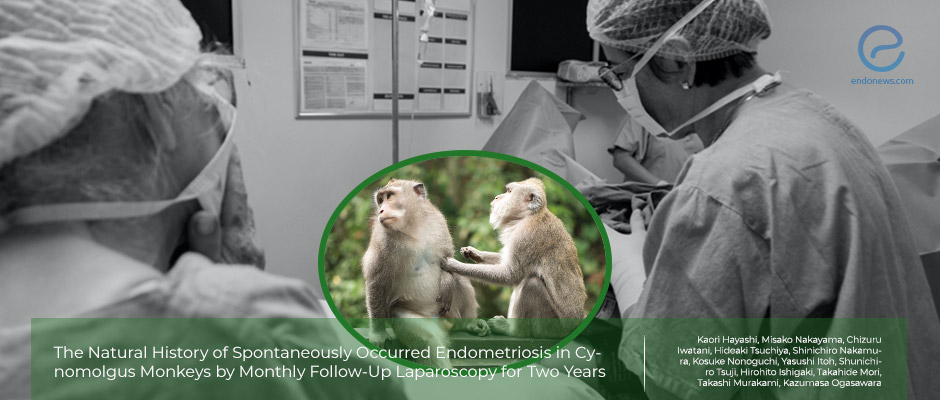Natural history of spontaneous endometriosis in crab-eating monkeys
Aug 19, 2020
Results of research on endometriosis in cynomolgus monkeys laparoscopically followed for two years
Key Points
Highlight:
- The natural history of endometriosis in monkeys with spontaneous endometriosis was studied by monthly laparoscopy for two years by a Japanese research group.
Background:
- Animal models of human disease are of utmost importance in medical research in revealing pathogenetic mechanisms and therapeutic interventions.
- Spontaneously occurring endometriosis in cynomolgus monkeys is unique in this regard.
Importance:
- Cynomolgus monkey with spontaneous endometriosis is a useful model for clarifying the underlying factors and the development of endometriosis, finding noninvasive quantification markers, and also for the examination of therapeutic interventions.
Key Results:
- All monkeys (n=11) revealed spontaneous endometriosis. Monthly laparoscopy and mapping of the lesions performed.
- The initial laparoscopies showed endometriotic lesions located at the vesicouterine pouch in 45.4%.
- The lesions spread to the Douglas’ pouch during the next two years.
- De novo lesions emerged (11/11), and some of the small lesions disappeared (2/11) during the observation period.
- The speed of progression of endometriotic lesions varied greatly among individuals which were attributed to the degree or frequency of retrograde menstruation besides genetic factors
Limitations:
- The small number of cases makes statistical analysis unfeasible and this could be overcome in the future.
- The endometriosis scoring system used in the study was not directly comparable to the human classification system of the revised American Society of Reproductive Medicine (r-ASRM).
- The effect of the monthly laparoscopies on the natural course of endometriosis is not known.
Lay Summary
Kaori Hayashi and associates from Shiga University of Medical Science, Japan, published their observations on spontaneously occurring endometriosis in crab-eating monkeys in "Tohoku Journal of Experimental Medicine"https://www.jstage.jst.go.jp/article/tjem/251/4/251_241/_pdf/-char/en. The presence of endometrial tissue outside the uterus, i.e., endometriosis is a progressive prevalent condition among women of reproductive age. Along with abdominal pain and infertility endometriosis severely affects the quality of life in young women.
Animal models of human disease are quite valuable in medical research in revealing pathogenetic mechanisms and investigating the effects of therapeutic interventions. Cynomolgus monkeys, also known as crab-eating monkeys have spontaneously occurring endometriosis that could be studied as an animal model of human disease.
The natural history of endometriosis in eleven cynomolgus monkeys was studied with monthly laparoscopies and mapping the lesions and adhesions in detail for up to two years. Minimally invasive laparoscopies were done by the same investigator being cautious for minimizing the suffering of animals. A practical scoring system was developed during the follow up of lesions, in which sizes of endometriotic lesions and adhesions were measured and endometriosis verification biopsies for pathology were taken.
In a previous preliminary observation by the same research team, spontaneous endometriosis in cynomolgus monkeys was found as 2.8% (5/219), with higher prevalence in those over 10 years old (3.77%, 4/106) than in those between 4-9 years old (0.8%, 1/113). This observation resulted in the inclusion of relatively younger monkeys, and 11 monkeys were used to observe the spatiotemporal development of the disease in the pelvic cavity. The animals were subject to monthly laparoscopies for up to two years.
Initial observations showed endometriotic lesions more frequently in the vesicouterine pouch contrary to human cases where favorite anatomical sites of endometriosis are the ovaries and pouch of Douglas. It is of noteworthy that even after two years of follow up no endometriotic cysts of the ovary (endometrioma) was observed, similar to a report from baboons. The high occurrence of endometriosis in the vesicouterine pouch in this and similar studies strongly favors the hypothesis of menstrual regurgitation causing dissemination and implantation of endometriotic tissues. The rate of progression varied greatly among each animal. This is an essential and important point with endometriosis animal models using nonhuman primates since they are genetically heterogeneous as humans.
This is the first study reporting the natural history of spontaneously occurring endometriosis in cynomolgus monkeys by mapping endometriotic foci and adhesions. This is a novel animal model of human disease that could be used for research for markers such as serum cytokines and exosomes to predict disease progression, and also the efficacy of therapeutic interventions.
Research Source: https://pubmed.ncbi.nlm.nih.gov/32713879/
endometriosis monkeys animal model of human disease natural history spontaneous endometriosis laparoscopy

